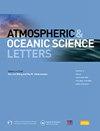Employment of an Arctic sea-ice data assimilation scheme in the coupled climate system model FGOALS-f3-L and its preliminary results
IF 3.2
4区 地球科学
Q3 METEOROLOGY & ATMOSPHERIC SCIENCES
引用次数: 0
Abstract
Arctic sea ice is an important component of the global climate system and has experienced rapid changes during in the past few decades, the prediction of which is a significant application for climate models. In this study, a Localized Error Subspace Transform Kalman Filter is employed in a coupled climate system model (the Flexible Global Ocean–Atmosphere–Land System Model, version f3-L (FGOALS-f3-L)) to assimilate sea-ice concentration (SIC) and sea-ice thickness (SIT) data for melting-season ice predictions. The scheme is applied through the following steps: (1) initialization for generating initial ensembles; (2) analysis for assimilating observed data; (3) adoption for dividing ice states into five thickness categories; (4) forecast for evolving the model; (5) resampling for updating model uncertainties. Several experiments were conducted to examine its results and impacts. Compared with the control experiment, the continuous assimilation experiments (CTNs) indicate assimilations improve model SICs and SITs persistently and generate realistic initials. Assimilating SIC+SIT data better corrects overestimated model SITs spatially than when only assimilating SIC data. The continuous assimilation restart experiments indicate the initials from the CTNs correct the overestimated marginal SICs and overall SITs remarkably well, as well as the cold biases in the oceanic and atmospheric models. The initials with SIC+SIT assimilated show more reasonable spatial improvements. Nevertheless, the SICs in the central Arctic undergo abnormal summer reductions, which is probably because overestimated SITs are reduced in the initials but the strong seasonal cycle (summer melting) biases are unchanged. Therefore, since systematic biases are complicated in a coupled system, for FGOALS-f3-L to make better ice predictions, oceanic and atmospheric assimilations are expected required.
摘要
当前, 快速变化的北极海冰对全球气候有重要影响, 海冰的预报是气候模式的重要应用方向之一. 本研究基于PDAF同化框架, 使用LESTKF方法将北极海冰密集度 (SIC) 和厚度 (SIT) 观测数据同化到气候系统模式FGOALS-f3-L中开展融化季节的海冰预测. 同化的引入共分为集合初始化, 同化分析, 分析场引入, 模式预报, 集合重采样等五个步骤. 试验表明, 连续同化可以持续改进模式模拟的SIC和SIT并生成接近真实的初始场, 同时同化SIC和SIT比只同化SIC能更好地纠正SIT的空间偏差. 利用连续同化生成的初始场进行预报, 能够显著减少海冰边缘的SIC多偏差, 整体的SIT厚偏差以及海洋和大气中的冷偏差, 使用同化了SIC和SIT的初始场能带来更合理的空间改进. 但受模式中海冰季节循环偏强的影响, 预报的夏季海冰会出现偏少, 这表明在耦合系统中准确预报海冰还需纳入海洋和大气同化.
耦合气候系统模式FGOALS-f3-L中北极海冰资料同化方案的应用及其初步结果
北极海冰是全球气候系统的重要组成部分,在过去几十年中经历了快速变化,其预测是气候模式的重要应用。在本研究中,在一个耦合气候系统模型(柔性全球海洋-大气-陆地系统模型,版本f3-L (faims -f3-L))中使用局部误差子空间变换卡尔曼滤波来同化海冰浓度(SIC)和海冰厚度(SIT)数据,用于融冰期海冰预测。该方案的应用步骤如下:(1)初始化,生成初始集成;(2)观测数据同化分析;(3)采用将冰态划分为五种厚度类别的方法;(4)模型演化的预测;(5)重采样更新模型不确定性。进行了几项实验来检验其结果和影响。与对照实验相比,连续同化实验(CTNs)表明同化持续改善了模型sic和sit,并生成了真实的首字母。同化SIC+SIT数据比只同化SIC数据更能在空间上修正高估的模型SIT。连续的同化重启实验表明,ctn的首字母可以很好地修正过高估计的边缘sic和总体sit,以及海洋和大气模式中的冷偏差。同化了SIC+SIT的首字母在空间上的改善更为合理。然而,北极中部的温度在夏季经历了异常的减少,这可能是因为过高估计的温度在首字母中减少了,但强烈的季节周期(夏季融化)偏差没有改变。因此,由于耦合系统中的系统偏差是复杂的,为了使FGOALS-f3-L做出更好的冰预测,预计需要海洋和大气同化。摘要当前, 快速变化的北极海冰对全球气候有重要影响, 海冰的预报是气候模式的重要应用方向之一. 针对PDAF同本研究基于化框架,使用LESTKF方法将北极海冰密集度(原文如此)和厚度(坐)观测数据同化到气候系统模式FGOALS-f3-L中开展融化季节的海冰预测。同化的引入共分为集合初始化, 同化分析, 分析场引入, 模式预报, 集合重采样等五个步骤. 试验表明,连续同化可以持续改进模式模拟的碳化硅和坐并生成接近真实的初始场,同时同化碳化硅和坐比只同化SIC能更好地纠正坐的空间偏差。利用连续同化生成的初始场进行预报,能够显著减少海冰边缘的碳化硅多偏差,整体的坐厚偏差以及海洋和大气中的冷偏差,使用同化了碳化硅和坐的初始场能带来更合理的空间改进。但受模式中海冰季节循环偏强的影响, 预报的夏季海冰会出现偏少, 这表明在耦合系统中准确预报海冰还需纳入海洋和大气同化.
本文章由计算机程序翻译,如有差异,请以英文原文为准。
求助全文
约1分钟内获得全文
求助全文
来源期刊

Atmospheric and Oceanic Science Letters
METEOROLOGY & ATMOSPHERIC SCIENCES-
CiteScore
4.20
自引率
8.70%
发文量
925
审稿时长
12 weeks
 求助内容:
求助内容: 应助结果提醒方式:
应助结果提醒方式:


